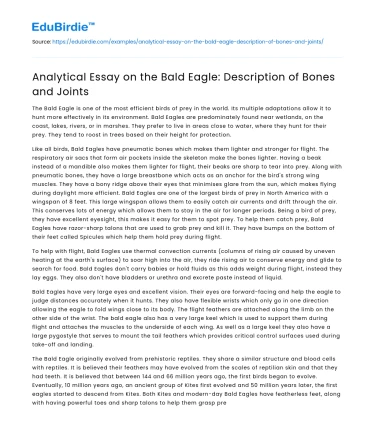The Bald Eagle is one of the most efficient birds of prey in the world. Its multiple adaptations allow it to hunt more effectively in its environment. Bald Eagles are predominately found near wetlands, on the coast, lakes, rivers, or in marshes. They prefer to live in areas close to water, where they hunt for their prey. They tend to roost in trees based on their height for protection.
Like all birds, Bald Eagles have pneumatic bones which makes them lighter and stronger for flight. The respiratory air sacs that form air pockets inside the skeleton make the bones lighter. Having a beak instead of a mandible also makes them lighter for flight, their beaks are sharp to tear into prey. Along with pneumatic bones, they have a large breastbone which acts as an anchor for the bird's strong wing muscles. They have a bony ridge above their eyes that minimises glare from the sun, which makes flying during daylight more efficient. Bald Eagles are one of the largest birds of prey in North America with a wingspan of 8 feet. This large wingspan allows them to easily catch air currents and drift through the air. This conserves lots of energy which allows them to stay in the air for longer periods. Being a bird of prey, they have excellent eyesight, this makes it easy for them to spot prey. To help them catch prey, Bald Eagles have razor-sharp talons that are used to grab prey and kill it. They have bumps on the bottom of their feet called Spicules which help them hold prey during flight.
Save your time!
We can take care of your essay
- Proper editing and formatting
- Free revision, title page, and bibliography
- Flexible prices and money-back guarantee
To help with flight, Bald Eagles use thermal convection currents (columns of rising air caused by uneven heating at the earth's surface) to soar high into the air, they ride rising air to conserve energy and glide to search for food. Bald Eagles don't carry babies or hold fluids as this adds weight during flight, instead they lay eggs. They also don't have bladders or urethra and excrete paste instead of liquid.
Bald Eagles have very large eyes and excellent vision. Their eyes are forward-facing and help the eagle to judge distances accurately when it hunts. They also have flexible wrists which only go in one direction allowing the eagle to fold wings close to its body. The flight feathers are attached along the limb on the other side of the wrist. The bald eagle also has a very large keel which is used to support them during flight and attaches the muscles to the underside of each wing. As well as a large keel they also have a large pygostyle that serves to mount the tail feathers which provides critical control surfaces used during take-off and landing.
The Bald Eagle originally evolved from prehistoric reptiles. They share a similar structure and blood cells with reptiles. It is believed their feathers may have evolved from the scales of reptilian skin and that they had teeth. It is believed that between 144 and 66 million years ago, the first birds began to evolve. Eventually, 10 million years ago, an ancient group of Kites first evolved and 50 million years later, the first eagles started to descend from Kites. Both Kites and modern-day Bald Eagles have featherless feet, along with having powerful toes and sharp talons to help them grasp prey during a long flight. Ospreys are believed to be descendants of Kites and have similar projections on their feet. Both have serrations on the roof of their mouths, which make holding prey a lot easier.
Did you like this example?
Make sure you submit a unique essay
Our writers will provide you with an essay sample written from scratch: any topic, any deadline, any instructions.
Cite this paper
-
APA
-
MLA
-
Harvard
-
Vancouver
Analytical Essay on the Bald Eagle: Description of Bones and Joints.
(2022, September 27). Edubirdie. Retrieved December 22, 2024, from https://edubirdie.com/examples/analytical-essay-on-the-bald-eagle-description-of-bones-and-joints/
“Analytical Essay on the Bald Eagle: Description of Bones and Joints.” Edubirdie, 27 Sept. 2022, edubirdie.com/examples/analytical-essay-on-the-bald-eagle-description-of-bones-and-joints/
Analytical Essay on the Bald Eagle: Description of Bones and Joints. [online].
Available at: <https://edubirdie.com/examples/analytical-essay-on-the-bald-eagle-description-of-bones-and-joints/> [Accessed 22 Dec. 2024].
Analytical Essay on the Bald Eagle: Description of Bones and Joints [Internet]. Edubirdie.
2022 Sept 27 [cited 2024 Dec 22].
Available from: https://edubirdie.com/examples/analytical-essay-on-the-bald-eagle-description-of-bones-and-joints/
copy






 Stuck on your essay?
Stuck on your essay?

